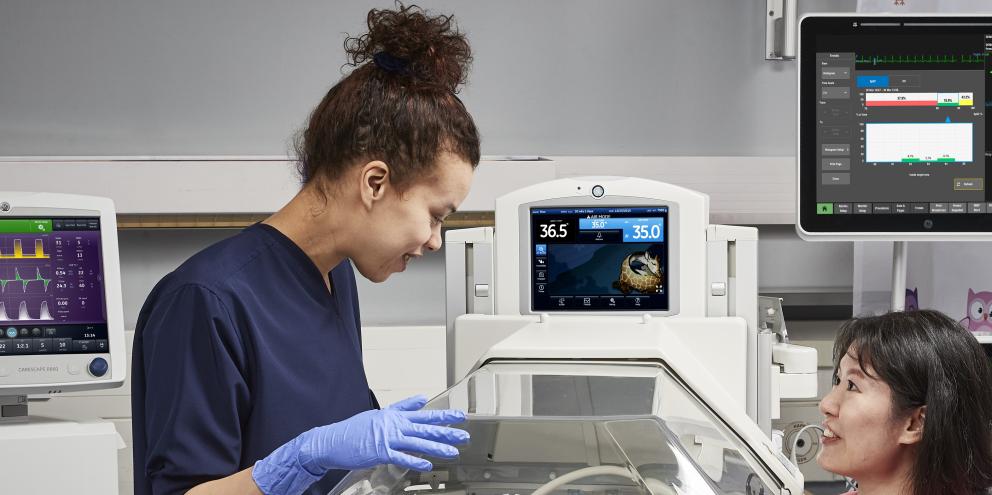Guidelines and protocols have been shown to improve outcomes by increasing consistency in care, according to research published in the American Journal of Respiratory and Critical Care Medicine.1
Technology can help keep infants safe, but it can also distract care providers. By having full knowledge of proper NICU devices and how they work, healthcare providers can help keep infants safe and comfortable when they need it most.
Supporting the Thermal Needs of a Newborn
Although clinicians are aware of the need for a neutral-thermal environment for newborns, it can be challenging to maintain one, particularly for extremely low birth weight infants and those who require extensive resuscitation. Hypothermia carries a substantial mortality risk, according to research published in Global Pediatric Health.2 Hyperthermia can be just as detrimental. Clinicians know that normothermia is paramount, but that often fades into the background when infants need respiratory support, surgery, and other intensive care procedures.
There are several innovative designs which help to support the patient and clinician to best achieve thermal stability.
Maintaining thermoregulation through automated tools can be useful with proper training. One of these tools is the Comfort Zone, which helps a clinician determine an appropriate temperature range to preheat the bed prior to admission. The GE HealthCare Giraffe™ OmniBed™ Carestation and Giraffe™ Incubator Carestation offer the Comfort Zone feature which is used to calculate suggested air temperature range based on gestational age, post-natal age, and weight.3
"The nurse just enters the gestational age, day of life, and weight, and the tool will bring up the baby's ideal set temperature shown as a range," says Alyson Krieger, a nurse and clinical lead with GE HealthCare.
Preheating a bed prior to admission avoids an initial drop in temperature for infants. The nurse is able to refer to the Comfort Zone for a suggested temperature range to preheat the bed without alarms sounding during preparation.
Another design is the air boost feature on incubators and hybrid beds that also helps keep temperatures consistent when the bed doors are opened or the side panel must be dropped. Activating the air boost is recommended in order to create a barrier that decreases heat loss. It provides a curtain of warm air inside the bed, avoiding temperature fluctuations that could result in infant instability. In addition the bed's double walls also serve to assist in maintaining temperature. Air flows between the walls, avoiding drafts while maintaining a constant temperature.
The Role of Algorithms and Temperature Probes
Beds are designed to achieve the desired clinical setting to ensure that the patient’s needs are met. Innovative algorithms, such as Cascade Control within certain incubators and warmers, like the GE HealthCare Giraffe OmniBed carestation, help manage the device heater output. This algorithm monitors the rate of the infant's temperature as it rises and then adjusts heat output accordingly. This is enabled by a skin temperature probe that accurately monitors the infant's temperature.
One common misconception is that skin temperature probe placement does not affect the accuracy of the temperature reading. In fact, Krieger says, "Temperature probe placement is huge. It should be on a fleshy area with good blood flow and covered only with the reflective pad. The reflective pad should always cover the temperature probe. If it is not used, other heat sources could directly heat the skin temperature probe tip and, therefore incorrectly display a temperature, which is not the patient’s skin temperature. This would result in a change in heater output which may not be necessary."
Another common misconception is that an independent temperature taken with a handheld device isn't as valuable as the temperature being read from a skin temperature probe. Different handheld thermometers use different algorithms, notes Krieger. Most measure temperatures using a predictive algorithm, per research from Medical Engineering and Physics.4 A skin temperature probe, on the other hand, continuously measures skin temperature. However, reviewing thermometer readings along with the skin probe temperature is an excellent way of determining the correlation between skin temperature and the secondary site.
Humidification: Common Misconceptions
A systematic review published in Advances in Neonatal Care reports that humidification of an infant's environment is vital.5 Humidity levels of 60% to 70% in the first week of life are effective in preventing excessive fluid loss. Humidity serves to stabilize the infant's temperature and aids in skin maturation.
The GE HealthCare Giraffe OmniBed carestation and incubators both have humidification features that can be controlled and monitored from outside the bed. Water reservoir levels are easily visible and help determine when the water needs to be refilled.
Many clinicians are concerned about the work involved with cleaning the incubator or hybrid bed if humidification is used, along with the risk of bacteria or mold growth. However, the OmniBed carestation's removable reservoir is designed to be easy to clean, with no draining or wait time required. "There is no water remaining in any tubing inside the bed" when the tank is removed, Krieger adds.
Another misconception about humidification is that any visible fog or mist inside the bed means the unit is malfunctioning. If a fog forms, it is simply related to the temperature gradient from hot to cool. "This is most likely when humidity levels are set quite high," says Krieger. The Advances in Neonatal Care review shows that condensation usually only appears in an incubator when humidity levels are over 90%.5
Open vs. Closed Mode
The hybrid bed has revolutionized neonatal care for the smallest, most fragile infants. "Having a bed that is an incubator when closed and maintaining a stable thermal environment, but also a warmer when needed, decreases the number of times that we need to move the baby, avoiding excessive stimulation and negative touch," says Krieger.
Keeping a bed in closed or incubator mode is usually appropriate when the infant is stable and procedures are completed. Closed mode maintains a quieter, more neutral-thermal environment. "Opening it is going to disrupt that environment," says Krieger. The bed is designed to allow parents to sit at the bedside, drop the side wall, and be close to their baby even when they cannot hold them.
A bed may need to be opened during resuscitation or complex procedures when multiple people need quick, easy access to the infant. The mattress platform is designed to rotate which reduces handling. As a consequence, during procedures, no interruption in heat delivery or temperature monitoring occurs.
Using Trend Features as an Early Indicator of Potential Instability
Infants will gradually require less heat as they mature. This temperature change should not be sudden and should progress over days or weeks. If more heat is required to maintain an infant's temperature, it may indicate hypothermia or cold stress.
Hypothermia is a common marker of sepsis, notes research published in Hospital Pediatrics, particularly in preterm infants.6 "Using the clinical trending feature can be very helpful" in this regard, says Krieger. "Looking at temperature trends over time may alert a clinician to impending sepsis in the baby." This often underutilized feature allows the clinician to access information on temperature trending over time and compare environmental and patient temperature trends, mode of device heat delivery and humidity levels.
Family and Neurodevelopment Supportive Care
Parental access to their child prompts bonding. The infants beds' ability to accommodate a family member at the bedside without disturbing the infant can go a long way toward establishing early attachment. Features such as "an away screen that has a picture of a giraffe and personalizing the screen with the baby's name, current weight, and gestational age all take the scariness out of that whole space for parents," says Krieger.
In addition, the bed alarm speakers and alarm lights are directed away from the infant to avoid light and sound disturbing them as much as possible while maintaining safety. Incubators may also be covered to further decrease the infant's exposure to light and sound.
With the GE HealthCare family of infant beds, there is no real need to move an infant from one bed to another. The hybrid bed can function as an incubator and be used until the infant is ready to wean out to a crib. Weaning to a crib can be done easily in the hybrid bed by moving from patient-controlled thermal regulation to air-controlled thermal regulation. This avoids multiple moves between beds, reduces cleaning for hospital staff, and minimizes disruption for the infant.
Understand and Use All Features of NICU Technology
"When nurses get too busy with taking care of the patient, we may forget about these 'extras' that could help make care better and easier," Krieger reflects. That includes "accessories like shelves and side tables, where all of the equipment can be when placing lines or doing procedures." Nurses don't need to go to other locations to find the equipment they need while caring for an unstable infant.
Incubator technology has changed immensely over the years, and nurses should strive to keep up with current best practices. Hospitals should incorporate these practices into NICU guidelines that encourage the use of appropriate tools and technology to keep infants safe and warm—and promote a timely discharge to an anxiously awaiting family.
References:
- Kavanagh BP, Nurok M. Standardized intensive care. Protocol misalignment and impact misattribution. American Journal of Respiratory and Critical Care Medicine. 2015;193(1):17-22. doi:10.1164/rccm.201502-0314cp
- Trevisanuto D, Testoni D, de Almeida MF. Maintaining normothermia: Why and how? Seminars in Fetal and Neonatal Medicine. 2018;23(5). doi:10.1016/j.siny.2018.03.009
- Sauer, Dane and Visser, Archives of Disease in Childhood, 1984. 59, 18-22. doi:10.1136/adc.59.1.18
- Sullivan SJ, Seay N, Zhu L, et al. Performance characterization of non-contact infrared thermometers (NCITs) for forehead temperature measurement. Medical Engineering & Physics. 2021;93:93-99. doi:10.1016/j.medengphy.2021.05.007
- Glass L, Valdez AM. Preterm infant incubator humidity levels: a systematic review. Advances in Neonatal Care. 2020. doi:10.1097/ANC.0000000000000791
- Wood JK, Halvorson EE, Auriemma JR, et al. Clinical characteristics and health outcomes of neonates reporting to the emergency department with hypothermia. Hospital Pediatrics. 2018;8(8):458-464. doi:10.1542/hpeds.2017-0176
© 2023 GE HealthCare
GE is a trademark of General Electric Company used under trademark license. Reproduction in any form is forbidden without prior written permission from GE HealthCare. Nothing in this material should be used to diagnose or treat any disease or condition. Readers must consult a healthcare professional.
JB21725XX

Dr. Karen Starr Becker, PhD, BC-NNP
GE HealthCare Clinical Development Director, Maternal Infant Care









